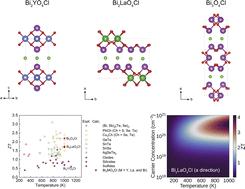Bi2MO4Cl (M = Y, La,和Bi)优异的热电性能来源于超低的晶格导热系数
IF 9.5
2区 材料科学
Q1 CHEMISTRY, PHYSICAL
引用次数: 0
摘要
层状混合阴离子氧化物被认为是热电材料的潜在候选者,因为它们通常具有氧化物(高温稳定性、低毒性和使用成本效益高的元素)和层状混合阴离子化合物(强声子非调和性和键非均质性)的优点。在本文中,我们使用密度泛函理论(DFT)计算预测了环境友好的层状混合阴离子氧化物Bi2MO4Cl (M = Y, La和Bi)的热电性能。结果表明,Bi3O4Cl和Bi2LaO4Cl在1000 K时表现出低于0.3 W m−1 K−1的超低平均晶格热导率,这是由重原子、弱离子键、强声子非调和性和低结构对称性共同作用所致。此外,弱离子键明显抑制了面外传热,导致面外方向的晶格导热系数相对于其他方向最低。结果表明,在可掺杂条件下,Bi3O4Cl的预测p型最大平均ZT在1000 K时达到2.20,优于目前已知的环保热电材料的热电性能,并且Bi2LaO4Cl的预测p型最大ZT在面外方向大于4。这些结果说明了Bi2MO4Cl (M = Y, La,和Bi)优异的热电性能的潜力,也突出了层状混合阴离子化合物在实现低晶格导热系数和提高热电性能方面的应用潜力。本文章由计算机程序翻译,如有差异,请以英文原文为准。

Excellent thermoelectric performance of Bi2MO4Cl (M = Y, La, and Bi) derived from ultra-low lattice thermal conductivity
Layered mixed-anion oxides are considered potential candidates for thermoelectric materials because they typically possess the advantages of oxides (high-temperature stability, low toxicity, and the use of cost-effective elements) and layered mixed-anion compounds (strong phonon anharmonicity and bonding heterogeneity). In this paper, we predicted the thermoelectric performance of environmentally friendly layered mixed-anion oxides Bi2MO4Cl (M = Y, La, and Bi) using density functional theory (DFT) calculations. The results show that Bi3O4Cl and Bi2LaO4Cl exhibit ultra-low average lattice thermal conductivities of less than 0.3 W m−1 K−1 at 1000 K, which are attributed to the combined effects of heavy atoms, weak ionic bonding, strong phonon anharmonicity, and low structural symmetry. In addition, the weak ionic bonding significantly inhibits out-of-plane heat transfer, resulting in the lattice thermal conductivity in the out-of-plane direction being the lowest compared to other directions. As a result, under dopable conditions, the predicted p-type maximum average ZT of Bi3O4Cl reaches 2.20 at 1000 K, which is superior to the thermoelectric performance of currently known environmentally friendly thermoelectric materials, and the predicted p-type maximum ZT of Bi2LaO4Cl is over 4 in the out-of-plane direction. These results illustrate the potential for the excellent thermoelectric performance of Bi2MO4Cl (M = Y, La, and Bi), and also highlight the application potential of layered mixed-anion compounds in achieving low lattice thermal conductivity and enhancing thermoelectric performance.
求助全文
通过发布文献求助,成功后即可免费获取论文全文。
去求助
来源期刊

Journal of Materials Chemistry A
CHEMISTRY, PHYSICAL-ENERGY & FUELS
CiteScore
19.50
自引率
5.00%
发文量
1892
审稿时长
1.5 months
期刊介绍:
The Journal of Materials Chemistry A, B & C covers a wide range of high-quality studies in the field of materials chemistry, with each section focusing on specific applications of the materials studied. Journal of Materials Chemistry A emphasizes applications in energy and sustainability, including topics such as artificial photosynthesis, batteries, and fuel cells. Journal of Materials Chemistry B focuses on applications in biology and medicine, while Journal of Materials Chemistry C covers applications in optical, magnetic, and electronic devices. Example topic areas within the scope of Journal of Materials Chemistry A include catalysis, green/sustainable materials, sensors, and water treatment, among others.
 求助内容:
求助内容: 应助结果提醒方式:
应助结果提醒方式:


